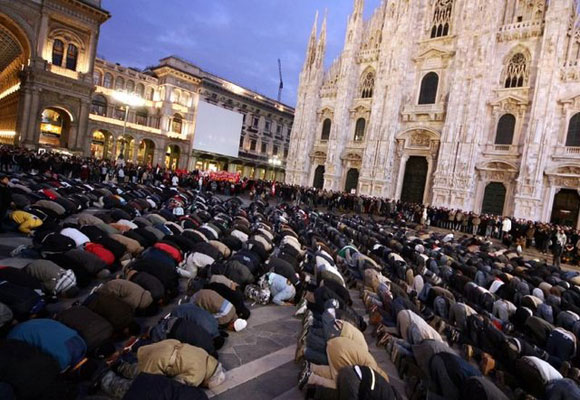Islam in Italy
Italy’s National Institute for Statistics (Instituto Nazionale di Stastica) does not collect data deemed as “sensitive,” which includes data on religious affiliation of its citizens. However, unofficial data from 2006 estimates that between 723,188 and one million Muslims live in the country.1 The UK Foreign and Commonwealth Office estimates that 825,000 Muslims live in Italy, of which between 140,000 and 160,000 are Italian born.2 A 2006 report by the US Department of State on religious freedom estimated that approximately one million of Italy’s 58.5 million residents were Muslim, roughly 1.7% of the entire population. However, an updated 2007 report on religious freedom in Italy makes no reference to the number of Muslims residing in the country.3
These differences in estimates are connected to growing and relatively recent waves of immigration, especially in the past 10-25 years.4 According to current estimates, persons coming from traditionally Muslim countries are the fastest growing immigrant group.5
In one statistic, between the early 1990′s and the early 2000′s, the Muslim population has in effect increased by over four hundred percent, from 154,400, to 825,000. In several European countries, including Italy, this recent increased migration has been connected to globalized issues and conflicts, markedly the rapid growth of refugees and asylum seekers beginning in 1979 with the Iranian Revolution and escalating with the Iran-Iraq wars, the two Gulf wars, the Taliban-Russian war in Afghanistan, the NATO-Taliban war, and the civil wars in the Horn of Africa, Sudan, and Algeria.6
In a 2007 report on religion and migration in Italy by Caritas Italia, it is believed that by the end of 2006, of the estimated 3,690,053 foreigners legally living in an Italy, 1,202,296 of were Muslim (respectively 32.6% of all foreigners), compared to 1,099,023 in 2005 (33.2 percent of all foreigners). This change of over 100,000 is thought to be connected to the rise in reunification of Muslim families in immigration trends.7
These “new Muslims” (that is, not Italian born) come from diverse countries of origin. Approximate numbers estimate that of the 825,000 figure of Muslims in Italy, 169,000 are originally from Albania, 172,000 from Morocco, 62,650 from Tunisia, 26,300 from Sub-Saharan Africa, 31,000 from Pakistan, 3,400 from India, and 32,000 from Bangladesh.8 With these diverse linguistic, cultural, ethnic, and social backgrounds, Muslims comprise the second largest religious community in the country; however, homogeneity among the country’s Muslims is not an actuality.9 Migrantes and Caritas have estimated that nearly half of Italy’s immigrants are Christian, based on the religious demography of origin countries. Defining immigration in Italy as an “Islam issue” is thus illusory, and accurate and rapidly changing statistics make reliable data challenging.10



